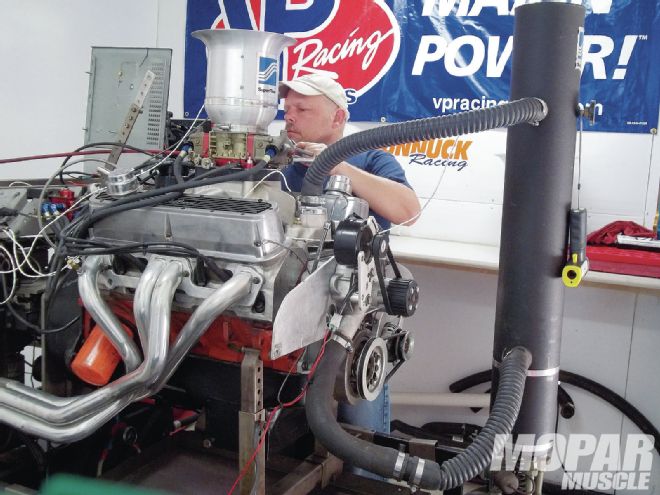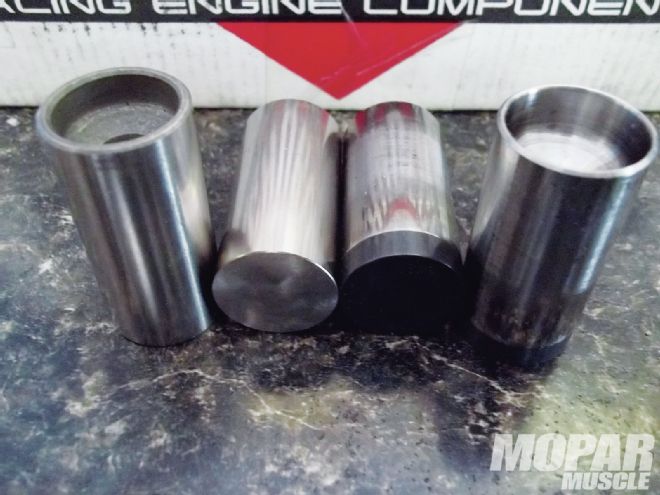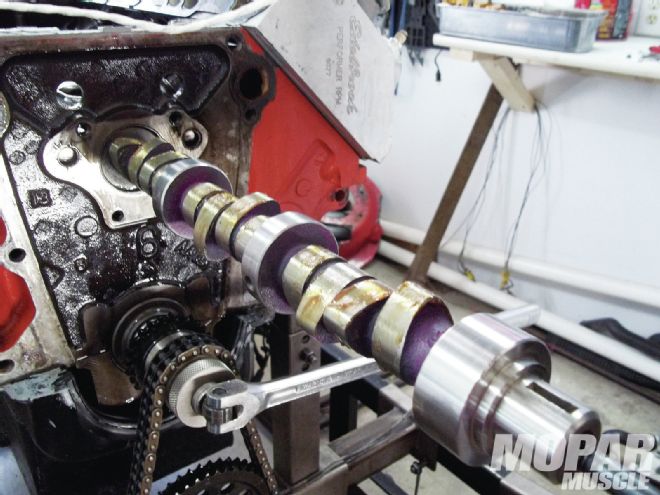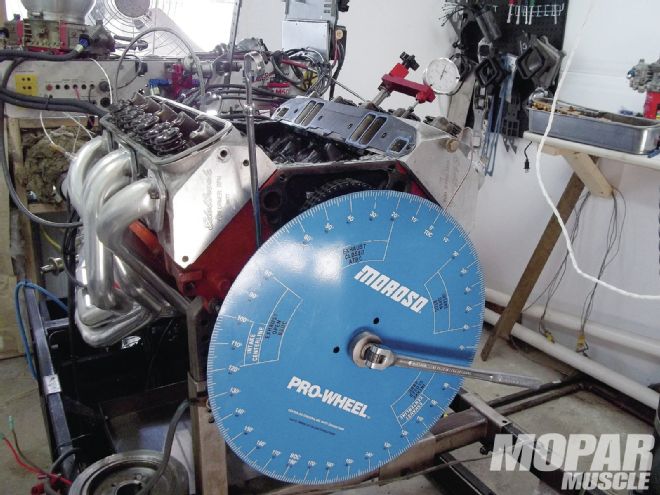
Camshaft selection has always been one of the hardest decisions we face when building an engine. Mopar's catalogs give suggestions for their line of camshafts based on the performance level you wish to achieve, and camshaft companies also give guidelines and approximate rpm ranges that their camshafts work within. And, if cam selection was difficult a few years ago, the choice is undoubtedly even harder today, when you consider the trend towards stroker crankshafts and aftermarket heads.
We decided to test a few of the Mopar Purple Shaft cams against some other cams from various manufacturers, to see how they compare in today's applications. Since our test engine is set up for use with a solid flat-tappet camshaft, we chose to stick with that platform throughout our testing. The test engine is a 421-inch small block based on a 360 block. We are using a Bloomer Performance Engineering 4.125-inch crankshaft, along with 6.300-inch H beam rods and custom 4.030-inch bore pistons to achieve a 13.0:l compression ratio when combined with our Edelbrock heads' 63cc chambers.
The Edelbrock Performer RPM heads were meticulously hand ported along with basic port matching of the Super Victor intake manifold by Vic Bloomer Cylinder Heads. We used a set of Crane Gold 1.6-ratio rocker arms and will list theoretical lift values with these in mind.
The engine was mounted to the Superflow dyno with a set of 1¾-inch Hooker Super Comp Headers, and topped off with a QuickFuel Q-950 Carburetor.
We ran all of our cams with a set of Schubeck Racing composite-faced lifters and set the valve spring load to meet their requirements. This allowed us to not need to break in several different camshaft and lifter combinations and the need to keep installing and removing the inner valve springs for proper break in.
To vary our camshafts, we decided to call a few cam companies and see what they recommended for this engine. Competition Cams offer their PN 20-249-4 as a nice street/strip cam that is comparable to the Mopar 557 cam. They also offered their popular TL300 Grind PN 20-632-4 as a performance improvement over the Mopar 620 grind.
Howard's Cams showed some promising grinds in their catalog, but they recommended a custom grind that would combine a moderate duration with a relatively high lift as an improvement over the Mopar 557 cam.
 We ran all of our cams with Schubeck composite-faced lifters and set the valve spring load to meet their requirements. By using “ceramic” lifters, this meant that we eliminated the need to break in several different camshaft and lifter combinations, and to keep installing and removing the inner valve springs for proper break in. Unfortunately, Schubeck Lifters are no longer in business.
We ran all of our cams with Schubeck composite-faced lifters and set the valve spring load to meet their requirements. By using “ceramic” lifters, this meant that we eliminated the need to break in several different camshaft and lifter combinations, and to keep installing and removing the inner valve springs for proper break in. Unfortunately, Schubeck Lifters are no longer in business.
Lunati Cams also got the call and recommended their 404A4 cam grind which is a comparison to the larger Mopar 590 cam in mind.
We also wanted to try a camshaft from Hughes Engines, who advertises a line of “Real Chrysler” cams. Dave Hughes recommended his HTL 6468AS Camshaft as a strong improvement over the Mopar 590 cam.
With all of these camshafts to be tested, that meant we would need to tear into our engine several times. So, we decided to try the new line of gaskets from Superformance. We ordered ours from Todd at Competition Wedge Engines. These gaskets held up great thru multiple teardowns.
For fair testing, we degreed each camshaft to the specifications shown on their respective cam card.
We started our test with the smallest Mopar Purple Shaft that we felt would work in our engine application, the 557 grind, PN 4120655. This cam has duration at .050 inch of 257 degrees on both intake and exhaust lobes, .594-inch lift, and a lobe separation of 110 degrees. This cam called for an installed centerline of 108 degrees. After a few pulls of the dyno to dial in the ignition timing, we got a peak horsepower of 557.9 at 6,500rpm, and a peak torque of 549.2 at 4,700 rpm.
The next cam selected was the Comp Cams grind PN 20-249-4. This camshaft had the same lobe separation, very similar lift numbers of .592 inch, and slightly longer duration of 262 degrees at .050 inch. Comp recommends it be installed at 106 degrees, compared to the MP 557's 108 installed centerline. The Comp grind really came on strong at low rpm, with a peak torque of 568.9 at 4,700 rpm and a horsepower peak of 540.5 at 5,700 rpm.
The next camshaft to be tested against the 557 was a custom grind from Howard's. This cam has a split duration at .050 inch of 260 degrees on the intake, and 264 degrees on the exhaust. Lift numbers were .656 inch on the intake and .662 inch on the exhaust, and a tighter 108-degree lobe separation. Howard's recommended it be installed at 104 degrees. This camshaft really helped our engine out on the top end, while still managing pretty respectable torque numbers down low with a peak torque of 565.8at 4,600 rpm, and a peak horsepower of 584.7at 6,800 rpm.
Next on our list was the next larger Mopar grind, the 590 camshaft PN 4120657. With duration at .050 inch of 271 degrees, lift of .629 inch, and a lobe separation of 106 degrees, Mopar recommends this camshaft be installed at 104 degrees. This camshaft has a good reputation as an excellent bracket-racing camshaft, and we can see why. Boasting a peak torque of 572.2 at 4,800 rpm, and a horsepower peak of 596.9 at 6,600 rpm, this was a definite step in the right direction.
 We started our testing with Mopar’s small Purple Shaft (PN 4120655). After a few pulls of the dyno to dial in the ignition timing, we got a peak horsepower of 557.9 at 6,500rpm, and a peak torque of 549.2 at 4,700 rpm.
We started our testing with Mopar’s small Purple Shaft (PN 4120655). After a few pulls of the dyno to dial in the ignition timing, we got a peak horsepower of 557.9 at 6,500rpm, and a peak torque of 549.2 at 4,700 rpm.
We also tested a camshaft from Hughes Engines to compare to the MP590, PN HTL6468AS. This camshaft features a split duration of 264 degrees at .050 inch on the intake, and 268 degrees at .050 inch on the exhaust, lift numbers of .634 inch intake and .651 inch exhaust, and lobe separation of 106 degrees. It was installed at the recommended 103-degree centerline. Proving to be a very nice grind for our engine with a nice torque curve and a very strong top end, our torque reading came in with a peak of 573.4 at 4,800 rpm. Our horsepower peak of 617.1 came in at 6,600rpm.
Lunati had sent their 404A4 grind for comparison. This cam had slightly less intake duration with 263 degrees at .050 inch, and exhaust duration of 271 degrees at .050 inch. Lift came in at .637 inch intake, and .661 inch exhaust. The lobe separation was again 106 degrees, and Lunati wanted it installed at 100-degree intake centerline. This camshaft performed pretty well with a torque peak of 563.4 at 4,800rpm, and a horsepower peak of 604.4 coming in at 6,900 rpm.
The final Mopar Performance grind tested was the now obsolete 620 grind, PN 4349266. Duration at .050 inch of 283 degrees on both the intake and exhaust lobes meant this camshaft was designed for high rpm use. Our lift numbers were .636 inch. This cam was ground on a 106-degree lobe separation, and was installed at Mopar's recommended 104 degrees. The torque dropped substantially throughout the range, and our horsepower level was also low, only managing to get a peak torque of 548.3 at 5,100 rpm, and a peak horsepower of 595.4 at 6,700 rpm.
Comp Cams suggested their TL300 grind, PN 20-632-5 as a performance upgrade for the MP 620, so we swapped it in for our final test. With duration numbers at .050 inch of 270 degrees on the intake side and 278 degrees on the exhaust side, and lift of .618 inch intake and .616 inch exhaust, it appeared to be a nice fit between the Mopar 590 and 620 grinds. Comp had their camshaft ground with a 108-degree lobe separation, and it was installed to their 108 degree recommendation. Peak torque came in at 5,100 rpm with a reading of 554.2, and horsepower came in with a peak of 581.2 at 6,500rpm.
 Throughout all of our testing, each camshaft was degreed per the manufacturer’s instructions.
Throughout all of our testing, each camshaft was degreed per the manufacturer’s instructions.
It is interesting to note that even though some of the camshafts tested had very similar averages over the entire rpm range, many times either torque or horsepower was substantially higher at a certain point, which could really help in certain combinations. For example, if you run a car with limited traction, trading off some torque down low for more power up top may help your car out with a better et.
We can see by the test, that going larger in degrees of duration moves the engine's torque peak higher into the rpm range, until you reach a point of too much duration for your combination. Our ported heads seem to like as much lift as we could give them. Your combination will most likely be different than ours in some way, but the more commonly available 4.00-inch stroke builds should react pretty similar to our test engine given the same basic components.
Price tag MP camshafts (sold as cam and lifter kits) PN 4120655 and PN 4120657 $199.95 each PN 4349266 $209.95 Lunati $193.39 Hughes $215.00 Howards (custom) $219.95 Comp Cams 20-249-4 $144.95 Comp Cams 20-632-5 $184.95